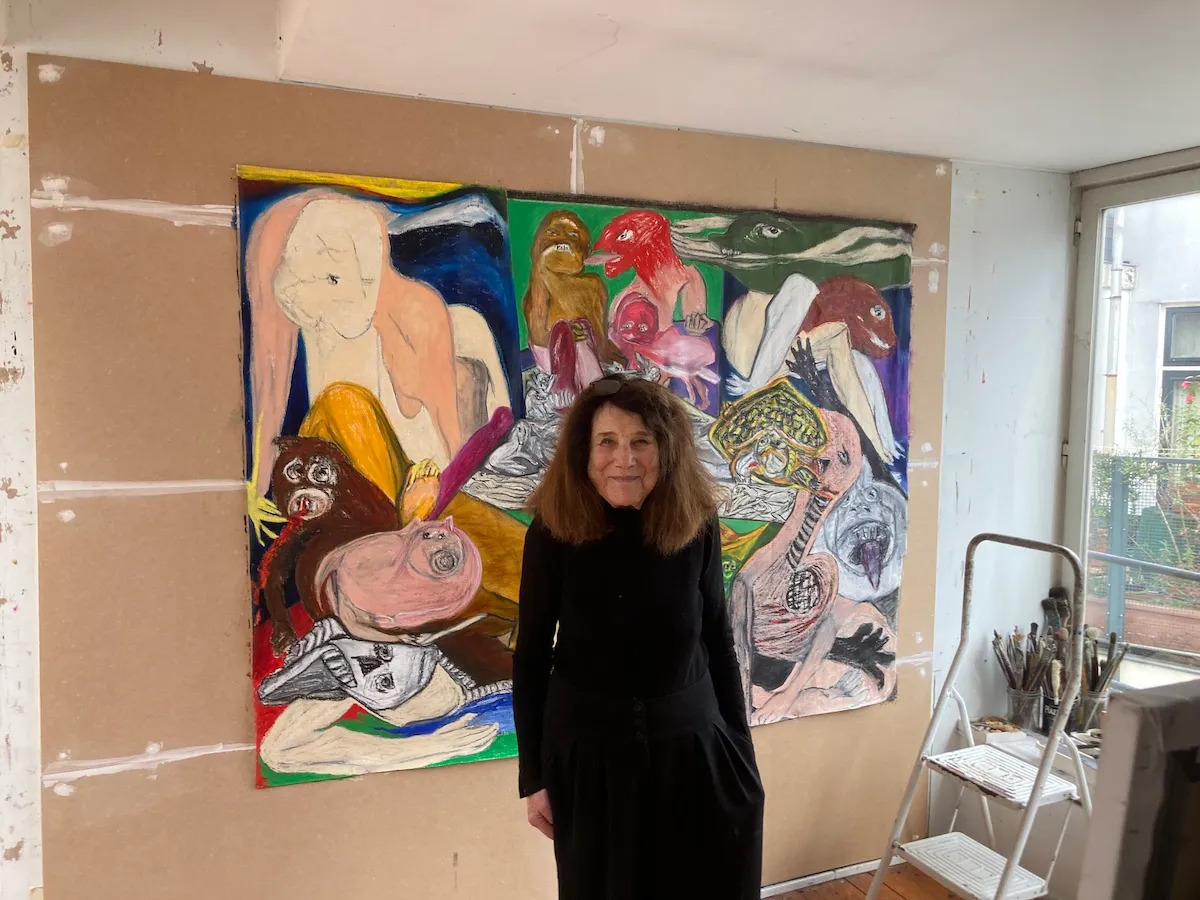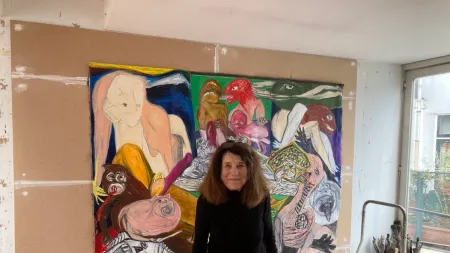
In October, Dutch painter Jacqueline de Jong was among those who encountered the images of rubble, corpses, and despair coming out of Gaza, and found herself rapt. The artist, who turned 85 two months ago, has never turned a blind eye to the horrors of war—in 2022, she also painted pictures based on photography coming out of Ukraine, where Russia has killed thousands and left many more disenfranchised. But when she encountered news reports on the October 7 Hamas attack in Israel and Israel’s subsequent war in Gaza, she knew she had to paint the images she saw.
On a recent afternoon, while in New York for the opening of her latest show, at Ortuzar Projects, de Jong pulled out her iPhone to show me an in-progress new work. After scrolling through pictures of her cat and snapshots of nature, she found what she was looking for: a shot of an unfinished painting partly based on the moment when Hamas, using a bulldozer, knocked down a portion of the fence that separates Israel from Gaza, which some have called an open-air prison. It was easy to spot familiar details: the steel structure being bent inward upon itself as dirt sprays up around it.
Was she afraid to show the work? “I don’t know,” de Jong said. “The works speak for themselves. But that’s what I always say.” She titled the work straightforwardly, simply calling it Gaza.
“There are all these reporters risking their lives, and some have died,” she continued, referring to the estimated 95 journalists who have been killed in the past six months, according to the Committee to Protect Journalists. “There’s also some who’ve made very interesting photos. It’s the images that really get to you.” Then I pointed out that she had, in fact, changed the image, adding expressionistic blasts that were not there originally. She raised a brow, and said that if she didn’t, the work “gets suffocated. It gets too illustrative, and that I don’t want. I want a bit of enigma.”
For the past six decades, de Jong has specialized in enigma, often with a heavy dose of humor that is not present in her Gaza painting. Her current Ortuzar Projects show features two series that are especially cryptic: one from the ’70s containing bizarre images of people playing pool, the other from the ’80s with salacious combinations of femmes fatales and violence culled from the covers of French paperbacks. They’re the kind of works that make you laugh, then seem to return that giggle with a query: What’s so funny?

To boil de Jong’s entire oeuvre down to a single idea feels unfair. She’s painted beast-like beings and refugee camps. She was affiliated with the Situationist movement of the 1960s; some critics have claimed that, two decades later, she could also be tied to the growth of the “bad” painting tendency of the 1980s. She’s worked at varying scales, producing objects as small as journals and paintings on sailcloth that span nine feet or more.
“She’s a free spirit,” said Devrim Bayar, who curated de Jong’s 2021 survey at the WIELS Contemporary Art Centre in Brussels. “One of the reasons why she maybe hasn’t gotten the recognition she deserves, I think, is the fact that she was never afraid to switch from one style to another, depending on what topic she wanted to address, what mood she was in. You can sense the energy that she has—it very much translates into the world. Even though she’s now an older woman, it’s still there.”
Two things bind her expansive oeuvre: a commitment to figurative painting, which has been unfashionable for almost the entirety of de Jong’s career, and an unironic sense of humor, something that critics have not always encouraged in contemporary art.
Speaking of the latter, curator Alison M. Gingeras compared de Jong’s work to the Situationist principle of dérive, the idea that one only gets a sense of their surroundings when they wistfully, aimlessly wander around, casually encountering things that interest them. “It’s humor, but it’s also play,” Gingeras said of de Jong’s work. “The artist is this vessel for play.”
De Jong herself exudes an openness that mirrors her work. On her trip to New York from Amsterdam, where she is based, she switched between two books she is reading: Anatoly Kusnetzov’s 1966 account of the Nazi massacre of thousands of Ukrainian Jews in Babi Yar and Paul Murray’s 2023 novel The Bee Sting, a family saga set in Ireland against the backdrop of the 2008 recession. In our conversation, she expounded on the differences between American pool and European billiards, and told me of her habit of growing potatoes, which she sometimes casts and turns into wearable sculptures. At times, she seemed keen to talk about anything that wasn’t art.
When she did speak about her art, she did not treat it as if it were the major contribution to painting that it is. At one point, she brought up the ’80s paintings based on pulp fiction, a series called “Série Noire,” whose imagery never quite communicates the stories narrated by the books these pictures initially accompanied. Take Rhapsodie en Rousse (1981), a work in the Ortuzar Projects show, in which a flinty redhead in a blue gown holds a switchblade, having apparently slain a sullen figure whose green dress leaks a thread of red blood. The rhapsodic quality of the title seems to have no bearing on these people themselves. That the work refuses to make sense is entirely de Jong’s point.

“That’s the meaning of my work,” she said, her big shoulder-length hair bobbing as she enthusiastically spoke. “It’s a bit of a joke, also.”
De Jong speaks of her work without reverence, which may seem odd for a child of collectors of art by Diego Rivera, Kurt Schwitters, and others. She was born to Jewish parents in the Dutch town of Enschede in 1939, and had a tumultuous childhood that saw her family dashing from the Netherlands to Switzerland and back again in an attempt to flee Nazi persecution. When she did finally attend college, in the 1950s in London, she studied not art but theater, then returned to Amsterdam, where she took a job at the Stedelijk Museum, all the while also pursuing an art history degree.
The year 1959 was the one that would put de Jong’s life on a new path. In London, she met Asger Jorn, an artist who cofounded the CoBrA movement, which embraced painterly techniques that looked slovenly and unprofessional. These works, with their chunky paint and misshapen figures, were meant as a riposte to accepted, bourgeois forms of art-making. Jorn, who was more than 20 years older than de Jong, became her romantic partner. The relationship, which lasted about a decade, coincided with her meeting other avant-gardists, including Guy Debord, a founding member of the Situationist International, a leftist French group that sought to combat the onslaught of pictures flowing in through the bourgeois mass media.
De Jong is typically mentioned as a footnote within the history of the plethora of avant-gardes who popped up in postwar Europe. If she is mentioned at all, it is for dating Jorn or for founding the Situationist Times, a short-lived publication tied to its titular movement. But de Jong is not much interested in discussing those things these days. Instead, she’d rather talk about figuration.
In 1960s France, the Narrative Figuration movement revived representational painting. “Perhaps it was a very much a sort of French movement against American Abstract Expressionism,” de Jong said. “That was part of it. But also, people like images, and people like to make images. That means artists like to make images. Which means figuration was lacking.”
The Narrative Figuration artists, who were all male, painted lofty allegories—for example, a vast triptych depicting the fictional assassination of Marcel Duchamp. De Jong’s work at the time, on the other hand, rendered candy-colored images of astronauts exploring space and dinosaurs copulating. Her inspiration, she said, was Peter Saul, the American painter whose toxically hued figurations set him apart from the Pop artists.
De Jong said the Narrative Figuration artists “never accepted me.” Because her work wasn’t so narrative-oriented? She countered with another question: “Or because I’m a woman?” Still today, she said, she never figures in exhibitions alongside them.
A sly feminist commentary has always percolated in some of de Jong’s works. In the “Billiards” paintings of mid-’70s, for example, we see lots of men playing snooker with long cues. These sticks get a grouping of paintings of their own, each with their dimensions scrawled on the canvas. It becomes obvious that the game is, in de Jong’s eyes, a measuring contest. “It’s a very sexual body of work, but it doesn’t look that way at first glance,” said Bayar, the curator of de Jong’s WIELS show. “It’s full of humor. And it’s also provocative.”

But that series is, in some ways, an exception, since de Jong’s work generally tends toward brightness and directness. During the ’90s, she did a series about the Gulf War, whose carnage she represented in blinding, colorful ways. The works were a retort, perhaps, to philosopher Jean Baudrillard’s assertion that, for Westerners, the conflict “did not take place” because the public had been so distanced from it via news reporting, military imaging, and more. By contrast, de Jong’s Gulf War canvases suggest that she had felt a proximity to the images coming in, and that she had no choice other than to study them and represent them in her own way, much as she has done more recently in her Gaza painting. One of the last works in the series depicts a pile-up of bodies beneath an airplane flying above.
She followed that series with another called “Harvest (After Malevich),” a play on a painting by Russian modernist Kazimir Malevich that is owned by the Stedelijk; it depicts workers harvesting rye. De Jong’s laborers are represented by vibrant planes of magenta, maroon, and mint green, as though their bodies contained the history of modernism. Figuration here subsumes abstraction.

Even following a 2018 retrospective in Toulouse, France, and the 2021 WIELS survey, de Jong is not widely known outside the Netherlands. But abroad, she has found a following among artists many generations her junior. In Los Angeles, for example, she is represented by Chateau Shatto, whose roster tends toward millennials.
Yet de Jong, for her part, seems not to mind whether her art is the subject of retrospectives or not. After all, she has for decades worked in a medium that is continually pronounced dead and then revived again roughly once every decade. With only a hint of sarcasm, she said, “Painting is always out of style.”
Tribeca Fixture Ortuzar Projects to Triple its Size with New Location
Ernie Barnes Estate Gets Gallery Representation Following Auction Surprise

Facebook’s Former CFO Drops a Record $52 Million on Malibu’s Point Dume

Ronny Kobo Celebrates New Partnership with the Wishi, a Personalized E-commerce Platform

Google One VPN is shutting down, but there’s already a better alternative

Spirit of St. Louis: UFL’s Battlehawks Are Proof of League’s Concept


